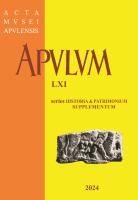SOCIETATEA BIBLICĂ RUSĂ ȘI TIPĂRIREA LA SANKT-PETERSBURG A SFINTEI SCRIPTURI ÎN LIMBA ROMÂNĂ
Russian Bible Society and Printing in Sankt-Petersburg of the Holy Scriptures in the Romanian Language
Author(s): Igor CereteuSubject(s): History, Cultural history, Modern Age, 19th Century
Published by: Muzeul National al Unirii Alba Iulia
Keywords: Bible; New Testament; Russian Bible Society; Saint-Petersburg; Bessarabia; Gavriil Bănulescu-Bodoni; diffusion; Moldavia; Wallachia;
Summary/Abstract: The decisive role in the printing and dissemination of the Holy Scriptures in Romanian in the second decade of the 19th century belongs to the Russian Bible Society (Российское Библейское Общество), established on January 11/23, 1813, in the house of Prince Alexander N. Golitzyn in Saint-Petersburg. This was the first Bible society in the world that gave birth to numerous societies, which printed and spread the Holy Scriptures in different languages. According to some estimates, from its founding until 1869, more than 50 billion Bibles were printed and distributed in 207 languages and dialects of the world. The British and Foreign Bible Society, established in London on March 7, 1804, served as a model for the establishment and organization of the Russian Bible Society. The activity of the Russian Bible Society was quite effective. In 1817, work was being done on 43 editions of the Holy Scriptures in 17 languages. Of the 17 translations printed by the Russian Bible Society, the Bible was edited in its entirety only in Romanian, Armenian, Finnish, and German, as well as in Ancient Greek and Slavonic. The Metropolitan and Exarch of Chișinău and Hotinu Gavriil Bănulescu-Bodoni (1812-1821) was involved in the printing of the Bible in Romanian. On September 27, 1817, the Bessarabian Branch of the Russian Bible Society, was supposed to support the activity of printing the Holy Scriptures, without interventions and comments in the text. The Metropolitan sent, at the request of the Committee from Saint-Petersburg, two copies of the Bible in Romanian: the edition from 1688 from Bucharest and the one from 1795 from Blaj. Gavriil Bănulescu-Bodoni recommended to the Saint-Petersburg Committee that the edition of the Bible from Blaj be taken as a model, because its text is clearer and the language is more understandable. Matei Crupenschi, who knew the Romanian language, was appointed to help. Gavriil Bănulescu-Bodoni requested the help of the abbot of the Dobrovăț monastery, Archimandrite Varlaam Cuza, a disciple of his, who knew the Romanian and Greek languages well, less Russian and Latin. Varlaam, together with a psalm singer were sent to the Saint-Petersburg. They worked quite intensively, so that in July 1816 the New Testament was ready for printing. In 1819, the entire Bible and the second edition of the New Testament were printed. The Bessarabian branch of the Russian Bible Society was concerned with the spread of the Bible and the New Testament in Romanian in Bessarabia, Transnistria, Moldavia and Wallachia. Through the mediation of hierarchs and merchants, these books printed in Romanian were distributed at a reduced price or given to poor Christians. The Romanians from Moldavia and Wallachia were entitled to thousands of copies of the Holy Scriptures in the Romanian language, which were distributed in record time. More than that, the Bessarabian Branch of the Russian Bible Society contributed to the distribution of Bibles in the Armenian, Greek, Slavonic, Hebrew languages among the representatives of these nationalities, established in Bessarabia and the Romanian Principalities.
Journal: Apulum
- Issue Year: 61/2024
- Issue No: 1
- Page Range: 147-167
- Page Count: 21
- Language: Romanian
- Content File-PDF

